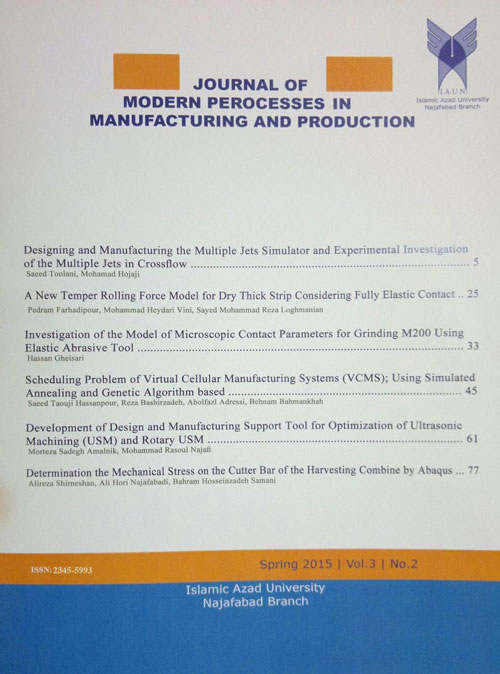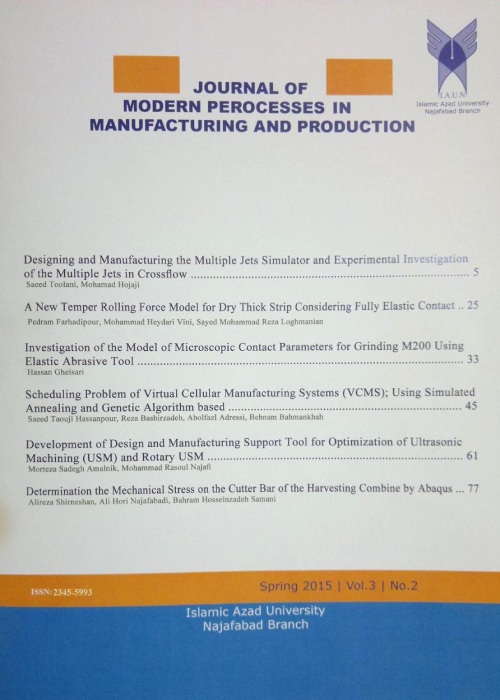فهرست مطالب

Journal of Modern Processes in Manufacturing and Production
Volume:7 Issue: 4, Autumn 2019
- تاریخ انتشار: 1397/08/10
- تعداد عناوین: 6
-
Pages 5-15Actuators of robot operate in the joint-space while the end-effect or of robot is controlled in the task-space. Therefore, designing a control system for a robotic system in the task-space requires the jacobian matrix information for transforming joint-space to task-space, which suffers from uncertainties. This paper deals with the robust task-space control of electrically driven robot manipulators. In conventional robust control approaches, the uncertainty upper bound is required to design the control law. This type of controller design is conservative that may increase the amplitude of the control signal and damage the system. Moreover, calculation of this bound requires some feedbacks of the system states which may be expensive. The novelty of this paper is addressing a robust control law in which the lumped uncertainty is modeled by a differential equation. The control design is simple, robust against uncertainties, and less computational. Simulation results verify the effectiveness of the proposed control approach applied on a two-link robot manipulator driven by geared permanent magnet DC motors.Keywords: Model-free Control, Electrically Driven Robot, Differential Equations, Robust Control
-
Pages 17-30The purpose of this paper is to identify and clustering strategic risks in the outsourcing field of partmanufacturing projects of aviation products, that whit survey carried out through the study of literature and experts opinion, meanwhile, identification risk groups in this area through interview, identified cases and factors of risks through FMEA technique, finally, 50 strategic risks identified in 7 titles. In the following to resolve problems of traditional FMEA method, with definition three indicators risk include, risk intensity, occurrence probability, and confrontation frequency by a questionnaire and considering from three factors outsourcing assess contain cost, time and quality, risks of this area were clustered to K-means clustering and using SPSS software in 4 cluster include of significant risks, high level of risks, medium level of risks and low level of risks. Thus, the clustering of risks for decision-making and planning of suggested actions at the time of their occurrence, basis for future improvements will be provided to carry out the continuous improvement process at appropriate intervals with assessment of actions taken, the rate of improvement identified and therefore appropriate decisions are achieved.Keywords: Data mining, Clustering, K- means Method, Risk, Aviation Industries, Manufacturing Project
-
Pages 31-39In recent years, investigations on accelerating of corrosion of Fe-Mn based alloys as biodegradable ones in orthopedic applications are aggrandized. Alloy composition is one of the effective factors in this case. This study is focused on the effect of the third element on the corrosion behavior of Fe35Mn alloy. For this purpose, four alloys including Fe35Mn, Fe35Mn2Ti, Fe35Mn2Ta, and Fe35Mn2Zr were produced by mechanical alloying. Then cylindrical samples of each alloy were fabricated by spark plasma sintering method (SPS) with pressing in 50MPa and sintering at 1000°C for 20 minutes simultaneously. All the specimens were evaluated by x-ray diffraction (XRD), light microscope, and potentiodynamic polarization test to compare the effect of the third element as Ta, Ti, and Zr. Results revealed that adding the third element increases the corrosion rate. It is found that the most effective element was Ta. Also, the weight changes of specimens after immersion in SBF at different times for predicting their probable behavior in the human body were measured. The foundlings could be utilized in medical applications.Keywords: Degradable Alloy, Microstructure, Electrochemical Measurements, Spark Plasma Sintering
-
Pages 41-55In the present article, the effects of friction stir welding (FSW) tool plunge depth (TPD) and tool tilt angle (TTA) were investigated on the heat generation and the material flow during solid-state joining of polycarbonate (PC) sheet experimentally and simulated with computational fluid dynamics (CFD) method. Simulation results showed that increasing heat input (higher TTA and lower TPD) could increase the size of the stir zone. Results indicate that control of TPD and TTA can improve the material flow near the top surface. The temperature field in the friction stir welding of PC was anti symmetric to the welding line. Due to the results, the heat generation and temperature distribution at the advancing side were more than the retreating side in all joint conditions. According to selected parameters, a strong sample was produced at 1.2 TPD and 2.5oTTA. This sample had 92% PC tensile strength, 89% PC flexural strength, and 86% of impact energy.Keywords: Friction Stir Welding, PC, Computational Fluid Dynamics, Mechanical Properties
-
Pages 57-70Electromechanical wrist hand orthosis1 is used under different conditions. It can be used for stability purposes for a wide range of wrist movements. Do not bend the joints or prevent excessive propagation. The materials used include low-temperature2 thermoplastic metal and thermoplastic sheets. To move the orthosis, a servomotor is used to move the wrist, which is controlled by the user interface. Instead of expensive fittings, a simple aluminum watch joint has been used to make it. To produce EWHO, first, the orthosis was designed by Inventor software. Depending on the wrist force, which is tolerable to the hand, this amount of force is analyzed on the sheets used in Abaqus software and Inverter software and analyzed for stress and ultimate stress. A Bluetooth board controls the movements of the wrist according to the user's command in the app depending on the type of user on the mobile or computer. The person or companion beside the person can help him or her to adjust the orthosis. Depending on one's disability, the orthosis can be adjusted to varying degrees and lead to one's recovery.The goal of this orthosis is to help patients with functional impairment in the wrist. Any type of functional disorder in his or her hand can result in the loss of individual independence and thus a threat to his or her social independence.Keywords: EWHO Orthosis, Bluetooth Range, Inventor Software, Abaqus Software, Thermoplastics, Splint the Wrist
-
Pages 71-80This paper presents an improved version of the article “task-space control of robots uses an adaptive Taylor series uncertainty estimator” by designing a more general framework for dealing with actuator saturation. There are four important issues about the aforementioned article. Firstly, the saturated and unsaturated regions have been discussed separately in that article, while this paper presents a unified approach for stability analysis. Secondly, the linear parameterization of unknown multi-variable vector-valued nonlinearities represented in the aforementioned article is not true. Consequently, it will affect the stability analysis significantly and the obtained results are doubtful. Thirdly, although the tracking error is bounded in the saturated area, it may be unacceptable due to undesirable performance. Thus, performance evaluation is needed to verify the satisfactory operation of the control system. However, in the aforementioned article, performance evaluation has not been presented. Fourthly, the aforementioned paper applies the Taylor series as a universal approximator without verifying the conditions of the universal approximation theorem. This paper proves that the Taylor series can satisfy the conditions of this theorem. All these four important issues are addressed in this paper and a modified version of the aforementioned article is presented.Keywords: Adaptive Uncertainty Estimation, Stability Analysis, Actuator Saturation, Electrically Driven Robots


